Using Gamification to Teach Undergraduate Students about Scientific Writing
Published online:
Abstract
Despite its importance, scientific writing is often deprioritized in undergraduate biology classes. Reasons include assumed prior knowledge, lack of class time, tedious grading, and the complexity and challenges associated with quality writing. To help students develop their writing skills, we created a computer game called Playon Words, which covers the basics of sentence structure, organization, scientific style, and reference management. The game helps students to avoid common writing mistakes and helps instructors provide targeted writing guidance without consuming much class time.
To assess the effectiveness of the Playon Words game, we offered it as extra credit in the Foundations of Biology course at the University of Minnesota. Seventy-seven students elected to play the writing game and agreed to have their data included in this study. These data suggest that the questions in the game were sufficiently challenging for our students and that student performance varied significantly with respect to each topic. A follow-up survey indicated that nearly 90% of the students reported learning some helpful writing tips from playing this game.
Citation
Gibbens, B.B., Gettle, N., Thompson, S. and Muller, K. 2015. Using Gamification to Teach Undergraduate Students about Scientific Writing. CourseSource. https://doi.org/10.24918/cs.2015.7
Society Learning Goals
Science Process Skills
- Process of Science
- Locate, interpret, and evaluate scientific information and primary literature
- Communication and Collaboration
- Share ideas, data, and findings with others clearly and accurately
Lesson Learning Goals
- Students will appreciate the importance of scientific writing and feel motivated to learn outside of class.
- Students will know that scientific writing involves many sub-skills that must be mastered and combined to form a successful final product.
- Students will understand how to critique scientific writing samples and thus be better equipped to judge the quality of their own writing.
Lesson Learning Objectives
Topics within Playon Words are grouped into “mini-games.” The Learning Objectives for each mini-game are as follows:
Sentence Sensei
- Identify the best sentence variant from a list of options
- Identify and eliminate needless words
- Identify where and when to use different types of punctuation marks
- Identify and correct common grammar mistakes
Organization Optimizer
- Organize sentences in a logical order
- Describe the components of different sections of a scientific paper
- Identify the section of a scientific paper where a given sentence belongs
- Eliminate sentences which do not belong in a given writing sample
Science Officer Training
- Classify statements as scientific or non-scientific
- Identify which statements support a particular hypothesis or position
- Classify provided sentences (e.g. hypotheses vs. predictions, problems vs. experiments, results vs. discussion)
Reference Referee
- Compare and contrast different types (e.g. primary literature, review articles, popular literature etc.) and sources (PubMed, Web of Science, Google Scholar etc.) of scientific information
- Identify locations in texts where citations are needed
- Identify citations and/or references that are incorrect or missing key information
- Identify information that does not belong in the reference list (e.g. vendor information)
Article Context
Course
Article Type
Course Level
Bloom's Cognitive Level
Vision and Change Core Competencies
Class Type
Class Size
Audience
Lesson Length
Pedagogical Approaches
Principles of How People Learn
Assessment Type
INTRODUCTION
Scientific writing is a fundamental, cross-disciplinary skill that is essential for the success of science majors in college and beyond. To write well, students must synthesize and clearly convey diverse ideas, a cognitively intense process that can facilitate learning (1). Additionally, employers are increasingly emphasizing the importance of a workforce skilled in written communication, often valuing such skills over technical or quantitative skills (2). This evaluation is particularly true in scientific fields where quality writing is required to attain employment (e.g. cover letters, curricula vitae, teaching philosophies) and achieve career success (e.g. grants, publications, posters).
Despite the importance of scientific writing, several factors conspire to deprioritize writing lessons in introductory biology classrooms. One of the biggest issues for many instructors is simply a lack of time (1). Introductory biology instructors may feel that there is little class time to teach writing skills, given the breadth of other material that must be covered. Grading student writing can also be time consuming and tedious. The grading workload can both deter instructors from assigning writing projects and lead to superficial feedback that fails to clarify areas in which students can improve (3). Another complexity of teaching writing is that students' writing skills are quite variable, an issue that is more noticeable in large classes. Instructors often assume that all their students already know how to research, write, and revise, but this is frequently not the case (4). This assumption can lead instructors to create challenging writing assignments that may inadvertently increase students' angst towards writing and reinforce misconceptions that good writing is an inborn (and not learned) skill (4). Writing is a multifaceted skill that requires students know the rules for spelling, grammar, sentence structure, organization, transitions, tone, and referencing in addition to content knowledge. However, the usefulness and transferability of writing are not always apparent to the novice learner. Both the daunting nature of writing and this perceived lack of importance are demotivating for students, and this problem can be difficult for instructors to overcome.
How can instructors motivate today's students to spend more time honing their scientific writing? Consider video games. In 2013, consumers spent $21.53 billion dollars on video games (5), which is almost double the $10.9 billion consumers spent at the box office (6). An estimated 59% of Americans play video games (5) and adult gaming is growing rapidly (7). The simple reason for this is that games are fun, challenging, and rewarding. Intriguingly, the National Academies Committee on Science Learning has stated that computer games are "worthy of future investment and investigation as a means to improve science learning" (7). The reason for this recommendation is that computer games are known to offer numerous benefits in an educational setting.
"Game designers are wizards of engagement. They have mastered the art of pulling people of all ages into virtual environments, having them work toward meaningful goals, persevere in the face of multiple failures, and celebrate the rare moments of triumph after successfully completing challenging tasks."
-Isabela Granic (8)
Different types of computer games have been reported to provide a wide range of benefits. One benefit of playing games is that they provide challenges that are very motivating to players (9-13). This increased motivation encourages practice and repetition (7), which can ultimately lead to long term retention. Educational computer games are also electronic, allowing students to play them at their convenience, at home, in the library, or on the bus. Electronic games can be integrated with learning management systems (e.g. Moodle, Blackboard, etc.), which makes it easy to assess student performance in traditional classes and in Massive Open Online Courses (MOOCs). In addition, games are very customizable. Users can oftentimes adjust the difficulty level or other variables to adapt the game to their needs, abilities, or preferences (7). Finally, games can provide instant feedback and offer tips (7); this feedback can help students to identify their strengths and focus their efforts on areas where they need the most improvement. These customization options allow the game to be challenging, but achievable by a diverse population of students.
While educational or "serious" computer games are not yet mainstream, there have been many successful educational games and more are created each year. One notable example is FoldIt, a game that teaches players about protein folding and allows them to predict the three-dimensional structures of complex proteins (14). Scientists can submit amino-acid sequences to the FoldIt database and gamers can then accurately predict the three-dimensional structure of the folded proteins. This interaction has already solved a protein structure that had baffled scientists for more than a decade (15). Other educational biology games include Phylo (16), WolfQuest (17), and numerous games designed to help medical students, doctors, and patients learn more about medical conditions and techniques (18-26).
While games have been created for a variety of subjects, no game appears to be available to teach students about scientific writing. We decided to create a game called Playon Words: The Biology Writing Game to fill this need. We sought to harness the demonstrated power and popularity of video games to motivate undergraduates to explore scientific writing concepts and skills. The resulting Playon Words game addresses many challenges of teaching writing by 1) motivating students to learn about scientific writing, 2) allowing them to learn outside of class so that instructors do not need to devote as much class time to this topic, and 3) allowing students of different writing abilities to identify their strengths and weaknesses and receive instant feedback on questions of varying difficulty. Here, we describe the creation and testing of the Playon Words game, as well as offer suggestions for those wishing to create or use educational computer games to teach scientific writing.
Intended Audience, Learning Time, and Pre-requisite Knowledge
Playon Words was created for use in the BIOL2002 Foundations of Biology class at the University of Minnesota. Each section of the class has about 171 students divided into 19 teams of nine. Most of these students are in their second semester of college and all of them are biological science majors. Students in this class are typically 65% white, 55% female, and 5% international. About fourteen percent of the students in this class are non-native English speakers. Most students are high achievers (i.e. average high school GPA is 3.9). Foundations of Biology meets three times per week in an active learning classroom (ALC, see http://www.classroom.umn.edu/projects/alc.html for more information). The only prerequisite for this course is Chemical Principles I.
The electronic/online nature of Playon Words allows it to easily adapt to classes of any size. Aside from a brief in-class introduction, no in-class time is required. Instead, this game can be completed in about 30 minutes outside of class. In order to play, students should have basic computer skills and access to an internet-ready computer. Students typically enter Foundations of Biology with little to no experience at reading scientific journals and at writing scientifically at the college level. A detailed description of how to write in biological disciplines is not required, but could be used to supplement the material covered in the game. Lastly, the current version of the Playon Words game requires that students be able to see their computer screen, so it may not work for visually impaired students.
Playon Words Description
Playon Words is a biology writing game that breaks down the writing process into discrete ideas that are easy to comprehend and apply. It focuses on four fundamental areas in science writing that are addressed in four “mini-games” (see Learning Objectives). These areas are: 1) grammar and usage, 2) structure and organization, 3) developing and supporting scientific arguments, and 4) appropriately referencing literature. Questions for each mini-game are randomly pulled from a database so each play-through is different. The mini-games require that students rearrange, order, or eliminate text; identify problematic regions of samples that need editing; or choose the best way of conveying some piece of information (Figure 1). Students receive instant feedback and have the ability to try again as needed. As students answer challenging writing questions, they earn points and progress towards finishing the game.
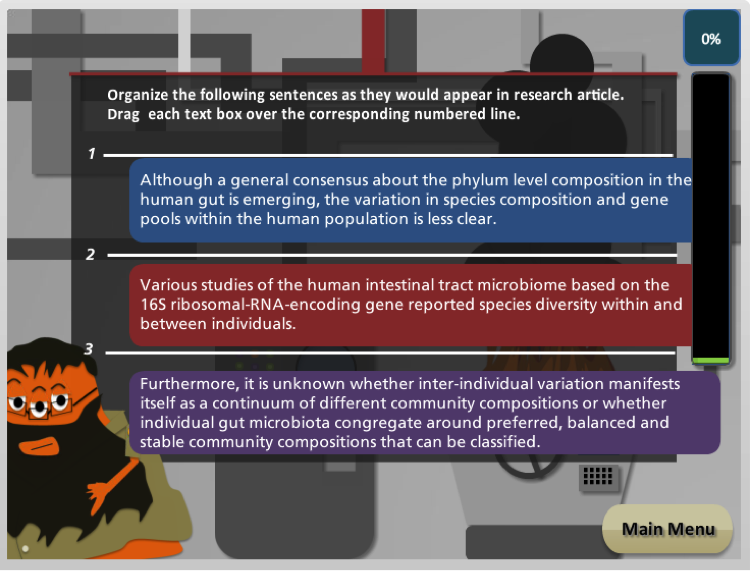
Figure 1: Example question from the Organization Optimizer mini-game. Questions in each mini-game largely draw from professional and student writing samples and require students to engage with and manipulate the text. In this example, students must use their knowledge about how scientific papers are organized to put the statements from a paper in the correct order. Text in this question was adapted from Arumugam et al. (2013) (30).
In addition to addressing writing challenges, we also wished to create an interactive learning environment that was enjoyable and engaging for students (27). To do this, we added a humorous backdrop and storyline, in which players find themselves on a spaceship run by Playons, a writing-obsessed alien race. The Playons are alarmed by the poor writing skills of humans and require the player to participate in their writing training program where he or she gathers points that ultimately allow them to finish the game.
Playon Words Development
The development and implementation of Playon Words followed a four-step process (Table 1). First, we identified core challenges in undergraduate writing instruction and strategies for addressing them (see introduction). We recognized that effective writing instruction can be challenging in content-heavy biology courses and thus chose to create an interactive self-guided activity to supplement (not replace) the standard writing curriculum. Having consulted the literature on educational computer games, we chose to create a game modeled on other successful games that utilize active problem solving, explicit and achievable goals, and a clear narrative to achieve higher user engagement (27).
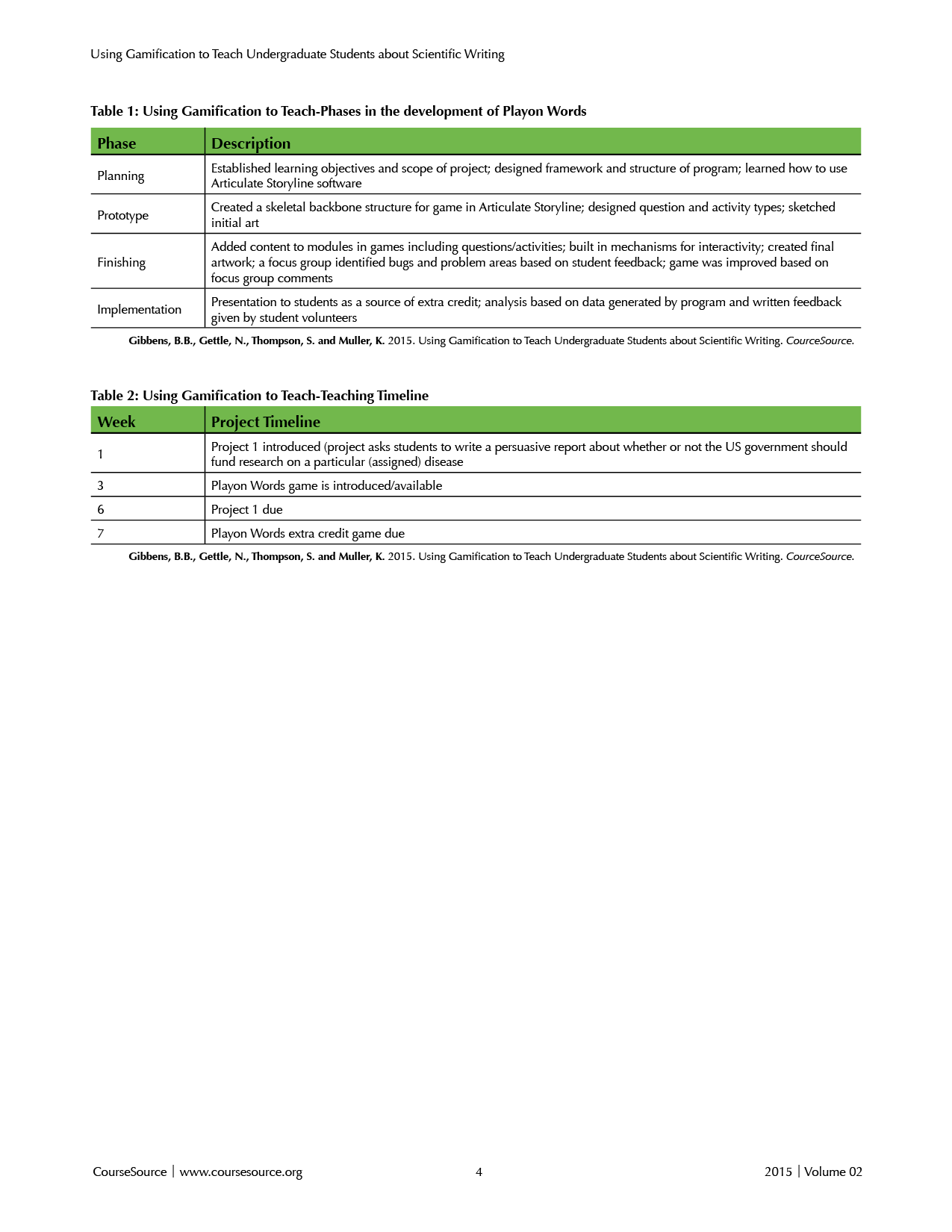
Table 1: Phases in the development of Playon Words
Table 2: Activity Timeline
Our second step was to create a prototype of the game to test out some of our ideas. Rather than coding the game from the ground up, we chose to work with Articulate Storyline, a software package designed for creating interactive online courses and presentations. Helpful supporting information and an active online community (see https://community.articulate.com/) enabled us to quickly create a prototype that included connections between modules, sketch art, and example questions and activities for each mini-game.
The third step of game creation was a finishing phase in which we added artwork, interactivity, dialogue, and questions to go in each module. Once the game was playable, we had two sections of Foundations of Biology students act as focus groups to provide feedback on different aspects of the game. These groups were concerned about the lack of a clear incentive to play the game and the lack of feedback associated with incorrect answers (Figure 2, Table 3). To correct these issues, we added explanations about why the correct answers were right and offered students extra points toward their course grade for playing the game. The improved Playon Words game was implemented during the following semester as an extra credit portion of the first major writing project (Table 2). Students were asked to fill out a brief follow-up survey after playing the game. Marked decreases in the 'review' and 'incentive' categories in Figure 2 indicate that the finishing phase helped to address the focus group's comments.
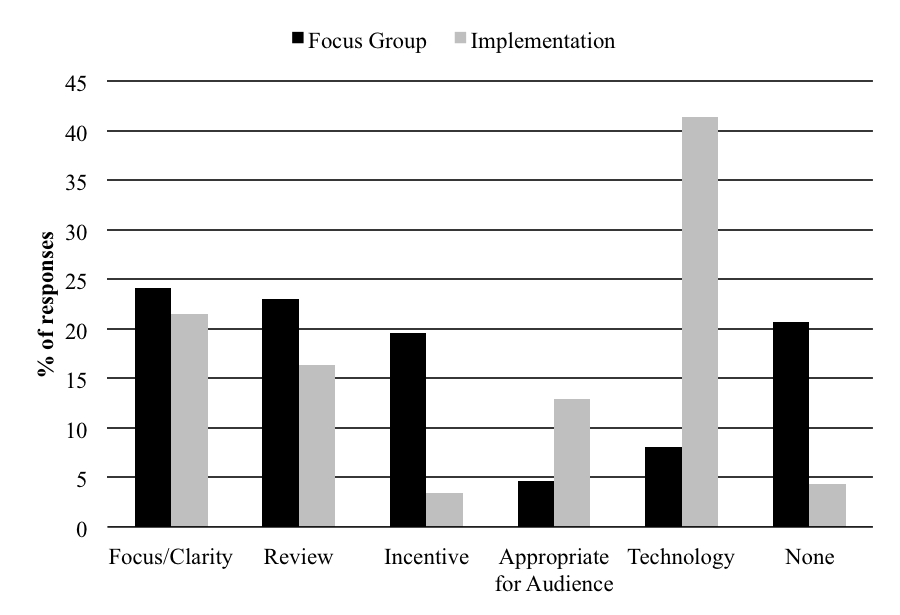
Figure 2: Student suggested game improvements. Breakdown of student suggestions for improvements to the game by various categories (description in Table 3). The 1st round of responses from our fall 2014 focus group were collected after students were asked to play the game on a volunteer basis (Focus Group); A total of 87 responses were collected. The 2nd round of responses were collected during the spring 2015 implementation after revisions had been made to the game (Implementation). During this semester, students were given extra credit points for completing the game, and a total of 116 responses were collected. Responses are shown as the percent of total responses for each category because of the different number of respondents in the focus group and the final implementation (87 vs. 116 respectively). Categories that scored high after the final implementation represent the areas to focus on for future improvements, not necessarily areas that were functioning poorly relative to the focus group testing.
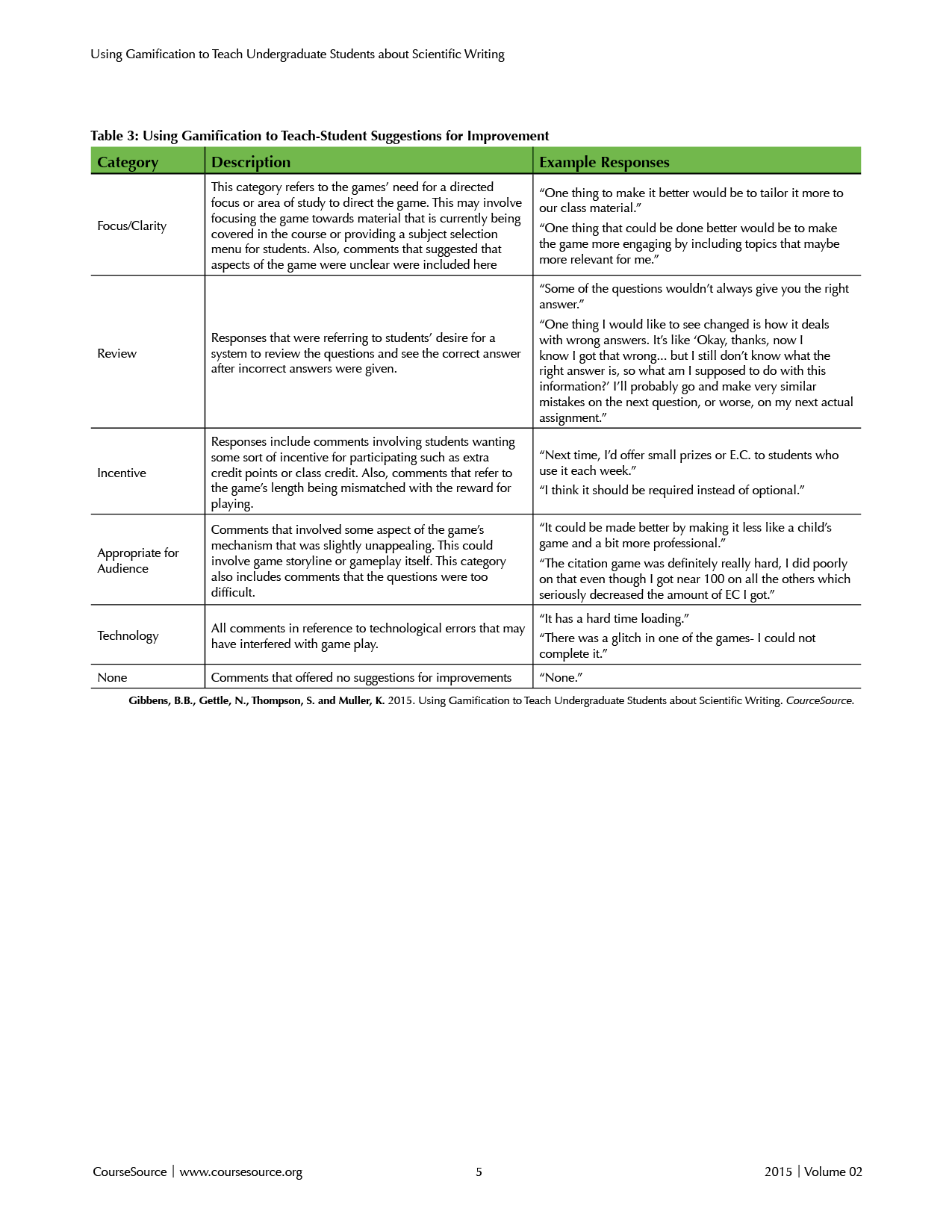
Table 3: Categories used to group student suggestions for improving Playon Words. Students were prompted to list three things they would improve about the game. Student comments were divided into categories and then quantitated (see Figure 2). Each comment belonging to an individual category increased that category’s total by one. If a comment related to more than one category then each of the affected category totals was increased by one. A description of each category as well as example responses are shown in the table.
SCIENTIFIC TEACHING THEMES
Active Learning
- Unlike books or television, games force students to make choices, the consequences of which impact the outcome of the game.
- A humorous backdrop and rigorous scoring system keep students actively engaged in their learning, which encourages them to master the skills being tested.
- Students engage in critically analyzing and evaluating the quality of scientific writing samples and gain the skills they need to evaluate their own writing.
- Students can complete the game in a relatively short period of time (~30 minutes), making it easy for them to play again in order to re-engage with difficult material and solidify their learning with a new set of questions.
Assessment
- Instant feedback allows students to self-assess their knowledge.
- Students' scores are reported to the class website so that instructors can monitor their progress in each content area tested by the game and emphasize problem areas in future classwork or assignments.
- Students' opinions about the game's effectiveness can easily be assessed using an online survey.
Inclusive Teaching
- Playon Words was designed to accommodate a diverse group of students with different learning preferences.
- Students can work through the game at a time, place, and pace that are convenient for them.
- Each mini-game asks questions of varying difficulty levels to meet individual students' needs.
- Students concerned about participating in a group setting because of a perceived lack of knowledge or general introversion can still participate.
- The game allows students who may need more writing practice (e.g. non-native English speakers) a safe environment to practice without risk of judgment from their peers.
LESSON PLAN
Foundations of Biology Writing Projects
The Playon Words game was designed to help students on their scientific writing on two major writing projects. Project 1 asks students to write a paper about whether or not the United States government should fund research on a particular disease (e.g. Dengue Fever or Cassava Mosaic Virus). To make their funding recommendation, students have to research and write about current funding for the disease, as well as the history, epidemiology, ecology, and molecular biology of the disease. They also have to highlight scientific and non-scientific statements in their final report. Project 2 asks students to use genetic technologies to address a social issue. For example, students may propose to create a drought resistant transgenic crop to increase crop availability in certain parts of the world. Final products of this project include a full-size color poster and a written component akin to a grant proposal. Both projects require that students read and cite at least 20 primary literature articles. They also require that students write in a clear, succinct, and organized way. Basic writing advice and tips were given in the project rubrics and in instructor feedback on student-submitted drafts.
Implementing Playon Words
The Playon Words game was available during both writing projects, but student data was only collected during the first project when students were most likely to use the game. During this implementation phase, we collected gameplay data from the 77 students who completed the game. Nine of these 77 students were non-native English speakers. Data were automatically collected from the majority of students and uploaded to a learning management system (Moodle, see S1 and S2). In addition to quantitative student score data, students also completed surveys in which they reported 1) how many times they played the game, 2) how much they think they learned (a Likert scale ranging from "nothing" to "a lot"), 3) three things they liked about the game, and 4) suggestions for improving the game. Students who tried the game were allowed to take the survey regardless of whether or not they completed the entire game. Of the 97 students who responded to our survey, 89 elected to include their responses in this study. All data collection and analysis procedures were in full compliance with the recommendations of the University of Minnesota's Institutional Review Board.
TEACHING DISCUSSION
The quantitative (game scores) and qualitative (survey feedback) data from the Foundations of Biology students indicate that the Playon Words game is achieving the stated learning goals and objectives. Mean scores on each mini-game varied, but the students generally did very well considering that they received little in-class writing instruction, and considering that the questions are based on common student writing mistakes (Figure 3). Students performed best at the Organization Optimizer game (mean = 73%) and also performed reasonably well on the Science Officer Training (mean = 66%) and the Sentence Sensei (mean = 64%) mini-games. Nearly 50% of the students who played the Sentence Sensei game received perfect scores (data not shown). In addition to this quantitative data, survey data indicated that nearly 90% of the student participants learned helpful writing tips from the playing this game (Table 4); more than half said they learned 'a lot' or 'a fair amount. Similarly, 86% of non-native English speakers learned something from playing the game and 64% said they learned 'a lot' or 'a fair amount' (data not shown). Student comments from the survey indicated that their experience fit with our stated learning goals (Table 5). The course instructor also noticed that student writing quality was improved when compared to previous semesters in which no game was administered; students made far fewer mistakes and submitted higher quality rough and final drafts (instructor observations).
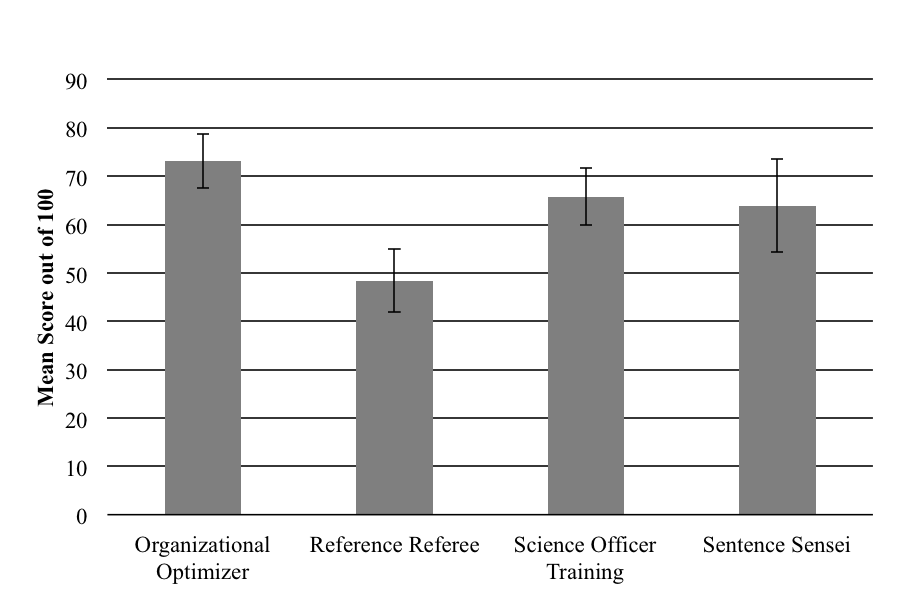
Figure 3: Mean scores for each Playon Words mini-game. From left to right, mean scores were 73%, 48%, 66%, and 64%. Mini-game type had a significant effect on mean student score (ANOVA, p < 0.0001) with Tukey HSD testing (α= 0.05) revealing that the Reference Referee game had a significantly lower mean score than the other three. Error bars represent 95% confidence intervals.
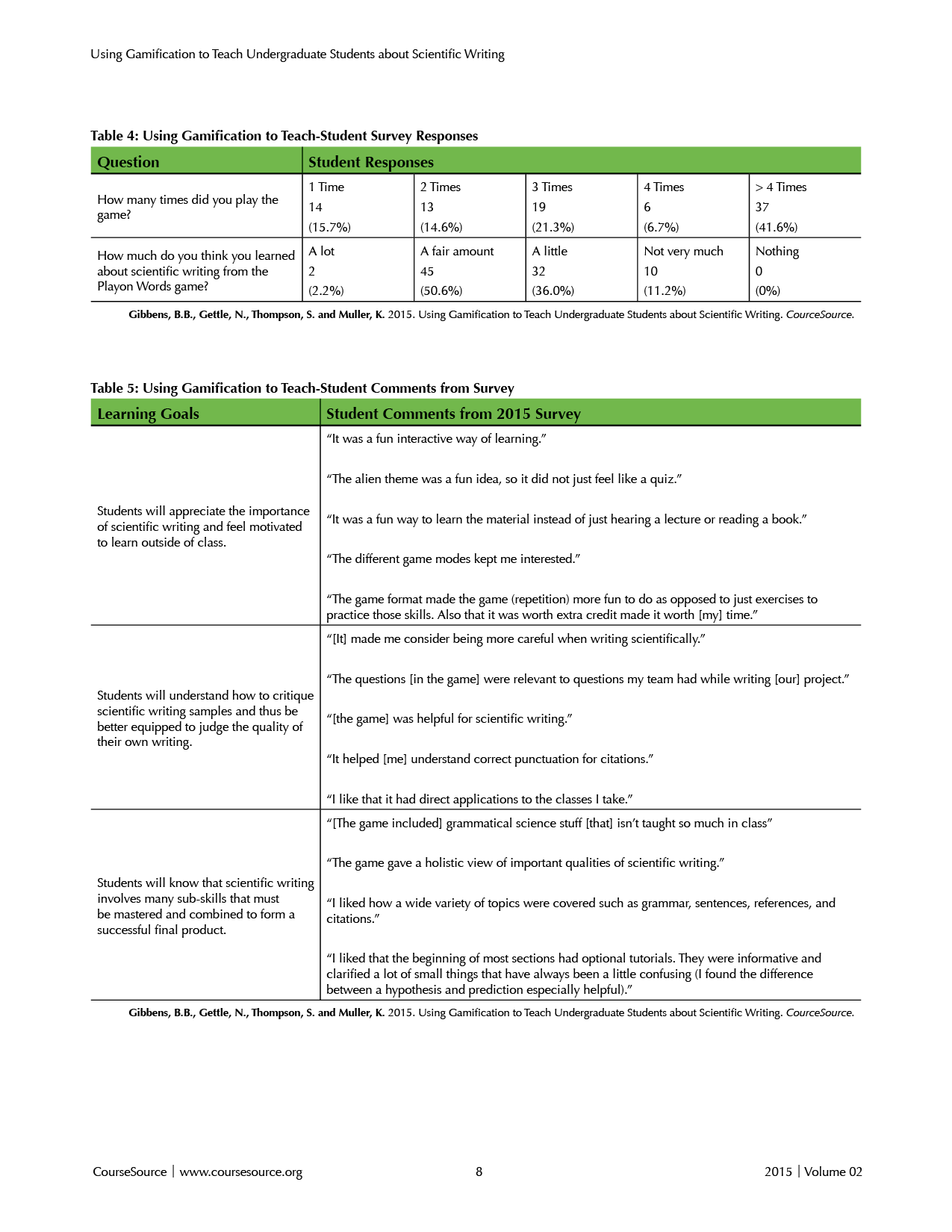
Table 4: Student responses to survey questions about their experience with Playon Words. Only responses from students who agreed to participate in this study are presented. Percentages are rounded to the nearest tenth of a percent.
Table 5: Student comments pertaining to learning goals
Game scores as an assessment and activity planning tool
Mean scores on each mini-game varied widely, ranging from 48% (Reference Referee) to 73% (Organization Optimizer) (Figure 3). This information indicated that students were clearly better at some writing tasks than others. Because scores were uploaded to the course website after each play-through, the instructor was able to use compiled score information to inform and alter classroom activities. For example, when it was learned that students were performing poorly on the Reference Referee mini-game, more class time was devoted to discussing citations and references.
Student motivation
Motivating students to play the game was crucial for achieving our learning objectives. By offering the game first without (fall 2014 focus group), then with extra-credit (spring 2015 implementation), we were able to compare student participation with and without an external incentive. When extra credit was added, student completion increased from 38% to 47% (data not shown). The participation rate in our initial focus group showed that the intrinsic factors of the game (score, entertainment value, etc.) were sufficient to motivate some students to spend their free time learning about scientific writing. The addition of extra credit encouraged more students to play the game, and likely played a role in students’ decisions to play the game repeatedly, since the amount of points they received was directly linked to their in-game performance. Surprisingly, 41.6% of students elected to play the game more than four times (Table 4). Instructors wishing to use this game for credit or extra credit in their classrooms should provide alternative options and additional writing support to any disabled students who are unable to play the game.
Many students commented positively about the humor in the game, suggesting that it contributed to their motivation to play. Research has found that integrating humor in teaching can enhance student performance and motivation (28, 29). However, some students commented negatively about the humor in the game, saying that it felt “cheesy” or “too young for college students.” While relatively few students made those comments, they point to the potential for humor to backfire in an educational setting and the need to approach humor with a deep understanding and sensitivity to the student population. Factors like age, gender, and culture of origin all play an important role in how people respond to humor (28).
Extension to other student populations
We have made the Playon Words game freely available through CourseSource (S2 and S3) so that other interested instructors can use and adapt it as they see fit. A playable version of the game can be found at https://goo.gl/aJ70cX. [Editor note: this link is no longer active, but readers can access the material through a shared Google Drive folder here]. It is our hope that instructors will 1) use the Playon Words game as it is, 2) modify it to better fit their classrooms, or 3) use it as a source of inspiration to generate their own educational games. Anyone with the Articulate Storyline software and the source files that we have provided should be able to make small changes to the game relatively easily. Small changes include adding or editing questions, backgrounds, or sound effects. Larger changes such as modifying the scoring system, adding additional mini-games, or changing the game's artwork are also possible but these changes will require more time and a more sophisticated knowledge of the Storyline software. One useful modification would be to include narration and other accommodations to make the game playable by students with visual disabilities. Instructors wishing to create their own educational game with Articulate Storyline can benefit from the wealth of online resources including the E-learning Heroes Community (https://community.articulate.com/), tutorials at Lynda.com (e.g. Up and Running with Articulate Storyline, by David Rivers), and free YouTube tutorials (e.g. https://www.youtube.com/watch?v=hXl5mBn6tZA). Other educational game creating platforms include Classcraft (http://www.classcraft.com/), Knowledge Guru (http://www.theknowledgeguru.com/), and Brightspace (http://www.brightspace.com/).
Conclusions
The words "fun" and "scientific writing" rarely appear in the same sentence. To a first-year undergraduate, scientific writing may seem intimidating and opaque compared to the types of writing with which they are more familiar. Playon Words is the first educational computer game focused on scientific writing at the undergraduate level. It is true that a game is no substitute for the years of trial and error that scientists must undergo to improve their writing. However, for early-career students who struggle to read scientific papers and write assignments for science classes, a game is a welcoming entry into the mechanics of scientific writing. While user-friendly programs such as Articulate Storyline can be a little clunky when it comes to designing games, they can allow science instructors to make fun and informative games without programming experience or the budget to hire professional game developers. We hope this example will empower other educators to utilize such technologies to enhance the learning experience of their students.
SUPPORTING MATERIALS
- S1. Using Gamification to Teach Writing-LMS integration
- S2. Using Gamification to Teach Writing-Playon Words with Moodle Integration
- S3. Using Gamification to Teach Writing-Playon Words
ACKNOWLEDGMENTS
We would like to thank Elizabeth Swanger for her contribution in designing and developing Playon Words as well as all of the Foundations of Biology students who played the Playon Words game and provided us with constructive feedback. Additionally we would like to thank Harsh Parikh for analyzing the data from our fall 2014 focus group. We'd also like to thank the staff at Articulate for their help and support during the game creation process. Finally we would like to thank Drs. Deena Wassenberg and Anna Mosser for allowing us to use this game in classes they were co-teaching.
References
- Pechenik JA. 2013. A Short Guide to Writing About Biology. Pearson Education, Inc., Upper Saddle River, NJ.
- Gray FE, Emerson L, MacKay B. 2005. Meeting the demands of the workplace: Science students and written skills. J. Sci. Educ. Technol. 14:425-435.
- Dirrigl FJ, Noe M. 2014. The student writing toolkit: enhancing undergraduate teaching of scientific writing in the biological sciences. J. Biol. Educ. 48:163-171.
- Krest M, Carle D. 1999. Teaching Scientific Writing. A Model for Integrating Research, Writing & Critical Thinking. Sci. Writ. 61:223-227.
- Entertainment Software Association. 2014. 2014 Essential Facts about the Computer and Video Game Industry.
- Motion Picture Association of America (Inc). 2013. Theatrical Market Statistics 2013.
- Honey MA, Bonvillian WB, Cannon-Bowers J, Klopfer E, Pellegrino JW, Perez R, Pinkard N, Schwartz D, Steinkuehler C, Wieman CE, Storksdieck M, Schwebach JR, Hilton ML, Krone R, Harvey P, Mukan W. 2011. Learning Science Through Computer Games and Simulations.
- Granic I, Lobel A, Engels RCME. 2014. The benefits of playing video games. Am. Psychol. 69:66-78.
- Erhel S, Jamet E. 2013. Digital game-based learning: Impact of instructions and feedback on motivation and learning effectiveness. Comput. Educ. 67:156-167.
- Huang WH, Huang WY, Tschopp J. 2010. Sustaining iterative game playing processes in DGBL: The relationship between motivational processing and outcome processing. Comput. Educ. 55:789-797.
- Jong BS, Lai CH, Hsia YT, Lin TW, Lu CY. 2013. Using game-based cooperative learning to improve learning motivation: A study of online game use in an operating systems course. IEEE Trans. Educ. 56:183-190.
- Przybylski AK, Rigby CS, Ryan RM. 2010. A motivational model of video game engagement. Rev. Gen. Psychol. 14:154-166.
- Yang YTC. 2012. Building virtual cities, inspiring intelligent citizens: Digital games for developing students' problem solving and learning motivation. Comput. Educ. 59:365-377.
- Cooper S, Khatib F, Treuille A, Barbero J, Lee J, Beenen M, Leaver-Fay A, Baker D, Popovi? Z, Players F. 2010. Predicting protein structures with a multiplayer online game. Nature 466:756-760.
- Khatib F, DiMaio F, Foldit Contenders Group, Foldit Void Crushers Group, Cooper S, Kazmierczyk M, Gilski M, Krzywda S, Zabranska H, Pichova I, Thompson J, Popovic Z, Jaskolski M, Baker D. 2011. Crystal structure of a monomeric retroviral protease solved by protein folding game players. Nat. Struct. Mol. Biol. 18:1175-1178.
- Leonardo MR. 2012. Playing the Game of Sequence Alignment. J. Microbiol. Educ. 13:95-96.
- Goldman KH, Koepfler J, Yocco V. 2009. WolfQuest Summative Evaluation Full Summative Report. Inst. Learn. Innov. 1-36.
- Boeker M, Andel P, Vach W, Frankenschmidt A. 2013. Game-based e-learning is more effective than a conventional instructional method: A randomized controlled trial with third-year medical students. PLoS One 8:1-11.
- Ozcan A. 2014. Educational Games for Malaria Diagnosis. Sci. Transl. Med. 6:1-2.
- Kanthan R, Senger JL. 2011. The impact of specially designed digital games-based learning in undergraduate pathology and medical education. Arch. Pathol. Lab. Med. 135:135-142.
- Gleason AW. 2015. RELM : Developing a Serious Game to Teach Evidence-Based Medicine in an Academic Health Sciences Setting. Med. Ref. Serv. Q. 34:17-28.
- Graafland M, Vollebergh MF. 2014. A Serious Game Can Be a Valid Method to Train Clinical Decision-Making in Surgery. World J. Surg 38:3056-3062.
- Kerfoot PB, Kissane N. 2014. The Use of Gamification to Boost Residents ' Engagement in Simulation Training The Automated Operating Room : A Team Approach to Patient Safety and Communication. JAMA Surg. 149:1208-1209.
- Nevin CR, Westfall AO, Rodriguez JM, Dempsey DM, Cherrington A, Roy B, Patel M, Willig JH. 2014. Gamification as a tool for enhancing graduate medical education. Postgr. Med J 90:685-693.
- Akl EA, Pretorius RW, Sackett K, Erdley WS, Bhoopathi PS, Alfarah Z, Sch?nemann HJ. 2010. The effect of educational games on medical students' learning outcomes: a systematic review: BEME Guide No 14. Med. Teach. 32:16-27.
- DeShazo J, Harris L, Pratt W. 2010. Effective intervention or child's play? A review of video games for diabetes education. Diabetes Technol. Ther. 12:815-822.
- Starks K. 2014. Cognitive behavioral game design: A unified model for designing serious games. Front. Psychol. 5:1-10.
- Torok SE, McMorris RF, Lin W-C. 2004. Is Humor an Appreciated Teaching Tool? Perceptions of Professors' Teaching Styles and Use of Humor. Coll. Teach. 52:14-20.
- Gorham J, Christophel DM. 1990. The Relationship of Teachers' Use of Humor in the Classroom to Immediacy and Student Learning. Commun. Educ. 39:46-62.
- Arumugam M, Raes J, Pelletier E, Paslier D Le, Batto J, Bertalan M, Borruel N, Casellas F. 2013. Enterotypes of the human gut microbiome. Nature 473:174-180.
Article Files
Login to access supporting documents
Using Gamification to Teach Undergraduate Students about Scientific Writing(PDF | 350 KB)
S1. Using Gamification to Teach Writing-LMS integration.docx(DOCX | 169 KB)
S2. Using Gamification to Teach Writing-Playon Words with Moodle Integration.story(STORY | 140 MB)
S3. Using Gamification to Teach Writing-Playon Words.story(STORY | 140 MB)
- License terms

Comments
Comments
There are no comments on this resource.